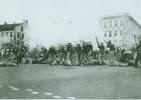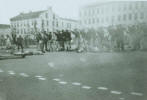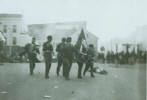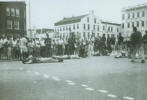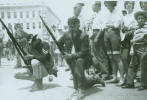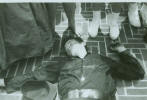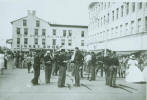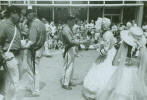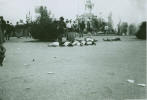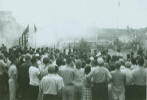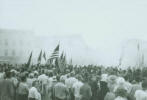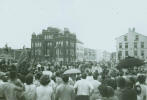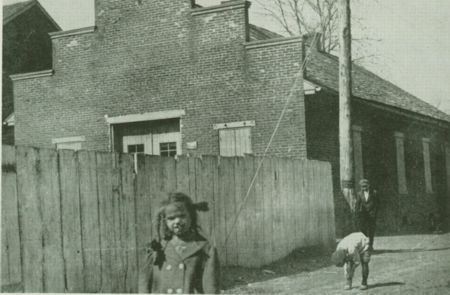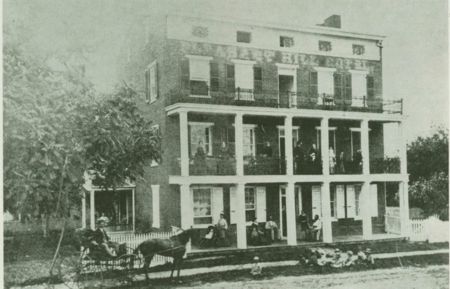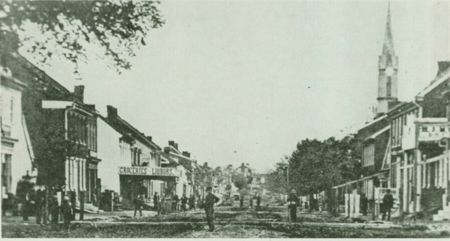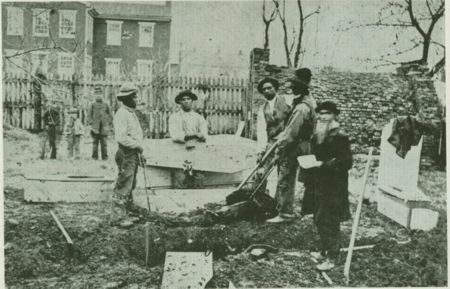Battle of Hanover Reenactment
June 30, 1963
Pictures in the left
column are courtesy of Barbara Chronister and were taken by
Bill Buehrle (Photo Shoppe on
Center Square) during the reenactment in 1963.

Official Program - Hanover Community Bi-Centennial Corporation
The Battle of Hanover
June 30, 1963
The Battle of Hanover was perhaps the turning point of Lee's northern campaign. Its results deprived Lee of his cavalry at a critical time. By delaying Stuart, it enabled the union troops to seize and hold commanding positions at Gettysburg. It is noteworthy that the troops on both sides were led by the most distinguished cavalry officers of the Civil War.
 |
|
Gen. Judson Kilpatrick |
In the disposition of troops by General Meade, Commander of the Army of the Potomac, at Frederick on the morning of June 29, 1863, General Gregg, in command of the Second Division of Cavalry, was sent through Westminster to Manchester to guard the extreme right of the Army of the Potomac and protect Washington from raids of the enemy. Buford with the First Division was dispatched across the ridge and took position on the plains around Gettysburg. Brigadier General Kilpatrick, who had just been placed in command of
The Third Division, was assigned the important duty of moving forward through Taneytown to Hanover, for the purpose of reconnoitering the position and ascertaining the movements of General Early who had occupied York on June 28th.
Kilpatrick moved forward to Littlestown, where he bivouacked for the night of June 29th. He took up the march at daybreak on June 30th from Littlestown to Hanover with his staff and body guard, a detachment from the First Ohio; Custer with four Michigan Regiments; Pennington's Battery; Farnsworth with the First Vermont, First West Virginia and Fifth New York; Elder's Battery; the ambulance wagons, horses and pack mules. The Eighteenth Pennsylvania Cavalry, commanded by Lieutenant Colonel William P. Brinton, brought up the rear, last to leave Littlestown.
One of three scouting parties of the Eighteenth Pennsylvania came into contact with the Confederates led by Chamblias who captured the third party, led by Lieutenant T. P. Shield and his twenty-five men.
UNION FORCES ENTER TOWN
At eight o'clock on the morning of June 30th, Kilpatrick came riding into Hanover, closely followed by the tall, handsome General Custer in his velvet uniform and flowing curls.
Generals Kilpatrick and Custer halted at the home of Jacob Wirt and at the Central Hotel, while the regiment filed slowly out Abbottstown Street, Kilpatrick, while in conversation with the Rev. Dr. W. K. Zeiber, pastor of Emmanuel's Reformed Church and who was present as chairman of the local committee of safety, mentioned that has men had had no breakfast. Rev. Zeiber announced this fact to the crowd assembled on the square. Everyone at once hastened to collect coffee, sandwiches, pies, cold meat and anything eatable that could be quickly prepared. Food and drink, tobacco and cigars were soon being handed freely to the passing soldiers. As the regiments halted briefly, many of the men dismounted and mingled with the people.
 |
|
Gen. J. E. B. Stuart |
General J. E. B. Stuart commanding three brigades of Lee's Confederate Cavalry Corps, moved northward, on the right of the Army of the Potomac. His orders were to meet General Early. at York and then proceed to Gettysburg.
Stuart's cavalry crossed the Potomac at Rowser's Ford. While at Rockville he was informed of the approach of a large wagon train on the way to Meade's Army. They captured it with little difficulty, but it must be acknowledged that the capture of these wagons was a misfortune. The delay caused by the subsequent march was serious at a time when minutes counted almost as hours. Had Stuart been entirely unimpeded, he would have probably passed Hanover on the 30th, before the arrival of Kilpatrick's divisions and would have been in communication with General Lee before nightfall on that day.
Stuart pressed on to Westminster which he reached about 5 o'clock. Here he obtained provisions for men and horses and then advanced to Union Mills where they rested for the night.
CONFEDERATE TROOPS APPEAR
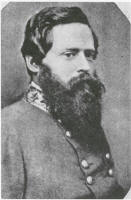 |
|
Gen. Fitzhugh Lee |
Early the next morning, Chambliss' brigade led the advance toward Hanover, arriving by way of the Westminster Road, where he placed two cannon on Samuel Keller's farm and two on Jesse Rice's farm.
Wade Hampton's brigade stretched along the Westminster road to guard the captured wagons. Fitzhugh Lee's brigade marched northward to guard the left flank from surprise.
ATTACK AND COUNTER-ATTACK
Stuart then ordered Colonel Payne with the noted Black Horse Cavalry to charge the rear of Farnsworth's Brigade. They dashed down the Westminster Road and came in contact with the Eighteenth Pennsylvania at the eastern edge of Pennville. The clashing of sabres, and the cracking of revolvers and carbines all told that a cavalry fight was ensuing. The Union troops were driven pell-mell through town in great confusion.
While the square was crowded with people, firing was heard out Frederick street and soon a cannon boomed. Major Hammond shouted to the people to run into their houses.
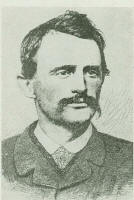 |
|
Gen. E. J. Farnsworth, USA |
The retreating Union cavalry men, closely followed by their grey-clad enemy soon came up Frederick street. The Union troops were driven out Abbottstown street to the railroad. Many soldiers dismounted and ran from their horses or if cut off, fled into alleys and houses, or jumped fences into yards and gardens in their eagerness to escape capture.
Loud shouts of triumph came from the Confederate throats as the Union men retreated. But the triumph was of short duration. Hammond's troop, the Fifth New York, along with the reformed Eighteenth Pennsylvania, were quickly turned back and on the town commons, formed in battle array. They made a countercharge, driving the Confederates head long through the town while some were driven across fields toward McSherrystown.
A spirited contest took place in a field at the rear of the present Methodist Church and continued out the Littlestown Road and between it and the Westminster Road. After this contest, twenty-seven horses and about a dozen men lay dead. Private Thomas Burke, of the Fifth New York, captured a Confederate battle flag. Lieutenant Colonel Payne, of the North Carolina Second, having had a horse shot from under him, fell into a vat at the Winebrenner Tannery on Frederick street and was subsequently taken a prisoner. Finally the Confederates were driven back to the cover of their artillery.
Stuart posted his artillery south of town on Cemetery Ridge, Fitzhugh Lee's brigade having come up the left. When Hampton arrived, his brigade was placed on the right extending beyond the York Road. Then Fitzhugh Lee was ordered to escort the wagon train to Jefferson and thence to York, while the other brigades stood off the enemy. When the wagon train was well on its way, Chambliss and his brigade was withdrawn and then Hampton's brigade brought up the rear. Heavy skirmishing parties were left to mislead the Union forces until nearly night. With the same object, artillery fire was kept up and threatening movements made at various places.
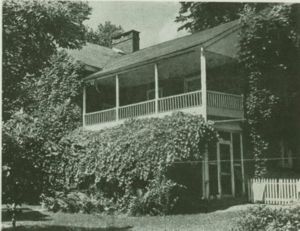 |
|
Henry Winebrenner residence on Frederick Street, showing rear balcony where shell from enemy cannon on Rice's Hill entered the house. The Winebrenner family still has the shell. |
KILPATRICK RETURNS
General Kilpatrick was near Abbottstown when he heard the enemy's guns and turned back. He took up his headquarters in the Central Hotel and ordered a strong line extended north of town, from New Baltimore to Bunker Hill. The batteries were placed on Bunker Hill at the end of Carlisle Street and started firing across town about three o'clock.
Farnsworth's brigade occupied the town and extended a line to the left along the Hanover Branch Railroad, east of town. The artillery duel occupied seven hours, the shells flying over the town, some lodging in streets and gardens but with little damage to property. When the scouts ascertained definitely that Stuart was retreating, Kilpatrick's men did not pursue because of his orders to keep in touch with General Pleasanton, head of Meade's Cavalry, and to keep Stuart away from Lee's main army. This being accomplished, Kilpatrick moved on to Abbottstown and bivouacked along the Pike the night of the 30th.
WOUNDED ARE CARED FOR
During the lull in fighting, after the first charge, the citizens carried the dead and wounded from the street and cared for the injured. Prominent in the work were Rev. Dr. W. K. Zeiber and the local physicians, Doctors Hinkle, Eckert, Alleman, Smith and Culbertson. There were eleven killed and forty-four "wounded during the battle.
Marion Hall, a small building erected by the Marion Rifles, several years before, located at the rear of York street and Concert Hall, on the Square, were used for temporary hospitals. At the foundry of the machine shops of J. and P. Flickinger, on York street, now the site of Trinity Reformed Church, the dead soldiers were prepared for burial. The bodies were interred in the grave yards of Emmanuel Reformed Church and St. Matthew's Lutheran Church.
Marion Hall, East Walnut Street, erected in 1860 as the armory for the Marion Rifles. It was used as a hospital after the Battle of Hanover and later as a school. It is now an auto parts store.
A few days later a United States Hospital was opened by authority of the government. What was then known as Pleasant Hill Hotel on the Baltimore road and had been used for a private academy, was rented by the government and all the wounded soldiers were transferred there. Dr. Gardner, an army surgeon, was in charge. Later a number of wounded soldiers from Gettysburg were also brought here for treatment.
Dr. Gardner summarized the Hanoverians' attitude throughout this trying time, when he wrote the following in a letteró
"Every desired comfort is furnished in great abundance, and every luxury with which the country abounds in great profusion, is supplied by sympathetic people, and administered to the suffering wounded by devoted women. A heartier response to the calls of humanity, never came from a more generous people than we have witnessed here."
Pleasant Hill Hotel, Baltimore
Road, was taken over by government as a
U. S. Cavalry hospital in |July and August, 1863
View northward on Carlisle St.
1865, showing St. Mark's Church Steeple,
a prominent landmark razed in 1958.
On January 7, 1864, Pennsylvania's Governor Curtin appointed David Wills, Esq., of Gettysburg as agent to purchase a site for "The Soldiers National Cemetery." Mr. Wills employed Samuel Weaver of Gettysburg to superintend the exhuming of bodies, many in unmarked graves. They had to be identified in various ways. In Mr. Weaver's report of March 19, 1864, to Mr. Wills, he said that 3,512 bodies had been exhumed and placed in new graves. Weaver's brother was P. S. Weaver, well known Hanover photographer. This picture shows the exhuming of the bodies of Union soldiers from the German Reformed Church graveyard, rear York street, Hanover, for removal to Gettysburg in 1864. Samuel Weaver is shown here with book.
Bibliography:
OFFICIAL PROGRAM of the BICENTENNIAL of the FOUNDING of HANOVER and the CENTENNIAL of the BATTLE OF HANOVER. Hanover Community Bi-Centennial Corporation. Hanover, PA. 1963

